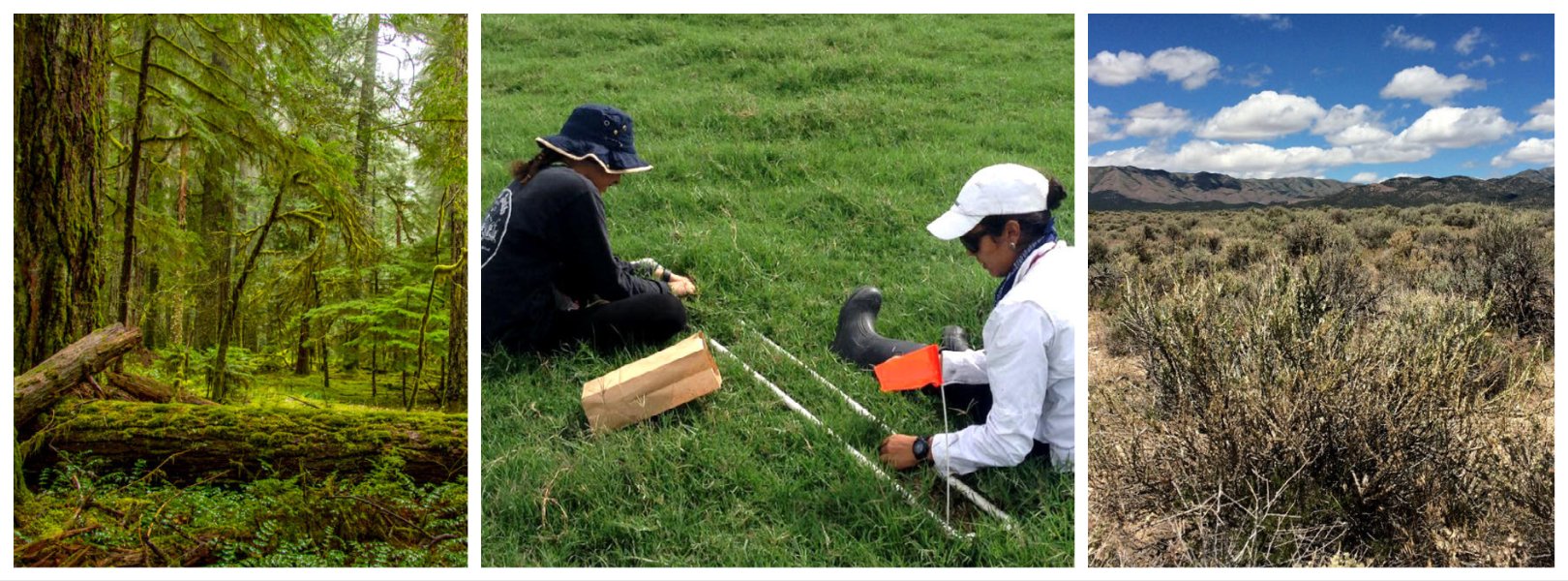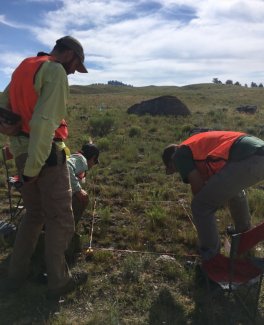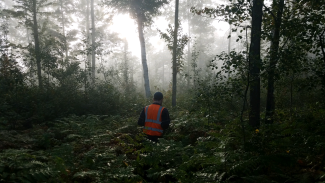Terrestrial Plants

Plants convert energy from the sun and carbon dioxide (CO2) into living matter; this process provides energy that sustains life and fuels ecosystem processes. Plants provide oxygen (O2) necessary for life on Earth and are the basis for most food webs. They regulate global carbon and water cycles and provide habitat for many species. Understanding ecological change is not possible without considering feedbacks between vegetation and other ecosystem components. To support the pursuit of this knowledge, NEON collects data on plant biomass and productivity, plant diversity, plant phenology, and plant chemical properties at terrestrial sites.
Plant Presence, Abundance, and Diversity: In addition to providing habitat for local fauna, the flora at each site integrates a variety of biotic and abiotic factors that respond to environmental change. Diversity surveys provide data necessary to understand and track changes to plant community composition over time and across spatial scales.
Plant Biomass and Productivity: Quantifying living and dead plant tissues at regular intervals enables calculation of above- and below-ground net primary productivity at each of NEON’s terrestrial sites. Human influences have perturbed the global biogeochemical cycling of carbon (C) and nutrients throughout the past century, with one obvious consequence being ever-increasing concentrations of atmospheric carbon dioxide. Forecasting the effects of these perturbations remains difficult because interactions between the atmosphere, terrestrial vegetation, and soils create feedbacks that may influence ecosystem C balance in opposing directions. Developing a better understanding of the spatial distribution and magnitude of above- and below-ground plant biomass stocks and fluxes is critical for the accuracy of large-scale models of the C cycle, and is key for understanding where shifts in the balance between ecosystem-level net primary productivity (NPP) and heterotrophic respiration may occur. The coordinated, standardized, and long-term measurement of both above- and below-ground plant biomass and productivity at the continental scale is an important contribution to the community that will enable better understanding and prediction of regional and global carbon and nutrient cycling.
Plant Phenology: Phenology is the study of relationships between climate and the seasonal timing of biological phenomena, such as bird migration and blooming dates. Plant phenology, which includes timing of leafing out, flowering, and fruit development, is one of the most sensitive and easily observed indicators of biotic response to climate variability. Plant phenology is also a potentially important driver of ecological responses ranging from the demographic trajectories of individual taxa to biogeographical species distributions to ecosystem processes. Timing of phenological transitions is affected by forces such as temperature, timing and duration of pest infestations and disease outbreaks, water fluxes, nutrient budgets, carbon sequestration, and food availability. Importantly, phenological shifts can themselves create feedbacks that alter species interactions and ecosystem processes such as trophic interactions and carbon cycling.
Plant Foliar Traits: Foliar traits include factors such as leaf mass per area, leaf water content, and concentrations of macro- and micro-nutrients (e.g., nitrogen, phosphorus, and manganese), as well as structural molecules (e.g., lignin). These traits have a large influence on many aspects of ecosystem function. Periodic sampling to quantify traits of sunlit plant foliage enables research into how and why these traits vary over space and time, both within and across NEON field sites. It also enables scaling and mapping of foliar traits using remote sensing data. Sampling sunlit foliage in tall-canopy sites is a challenge, but NEON is leveraging new technology to help efficiently procure samples. The below video shows more!
NEON collects terrestrial plant measurements and observations at all terrestrial sites to capture spatial variation and trends over time in plant abundance, diversity, biomass, productivity, phenology, and biogeochemical traits. In addition, information on terrestrial plants in riparian zones along NEON aquatic field sites is collected using a rapid habitat assessment. Characteristics of terrestrial plants are also captured by in NEON remote sensing data products collected from the Airborne Observation Platform.
Sampling Design and Methods

Monitoring plant diversity at the Yellowstone site. Research coordinated under Yellowstone Research Permit: YELL-2018-SCI-5870.
Standardized methods and a statistically-rigorous spatial sampling design result in data suitable to a diversity of analytical approaches and ecological questions for understanding the causes and consequences of ecological change. Plant species and individuals are documented and sampled from plots at terrestrial NEON sites. Distributed Plots allocated to dominant (>5%) cover types yield data that captures variability in vegetation across the site. Tower Plots, established in proximity to the NEON tower, generate plant data products designed to be linked to flux, meteorological, and phenocam data derived from instrumented data streams. For more details regarding Distributed and Tower terrestrial plot design please see Site-Specific Sampling Design.
Temporal designs, which determine data collection frequency and schedule, reflect the requirements of specific data products and associated protocols. Frequency of sampling ranges from 50 sampling events per year (phenology), to one sampling event every 5 years (e.g., coarse downed wood volume, fine root biomass) or even a single sampling event per site over the life of the Observatory (e.g., soil and root characterizations). Many terrestrial plant protocols implemented on 5-year intervals are synchronized in order to provide a more detailed picture of carbon and nutrient cycling in a given sampling year. Several terrestrial plant protocols are scheduled to co-occur with remote-sensing flights to enable explicit linkages between multiple data streams and maximize the scientific utility of the data products.
The spatial and temporal scheduling and implementation of terrestrial plant protocols is complex. Data users who wish to understand and leverage multiple terrestrial plant data products should consult the NEON Terrestrial Observation System: Spatial and Temporal Sampling Strategy document that can be downloaded with any terrestrial plant data product and found on the respective Data Product Details pages.
Collection
NEON terrestrial plant data are generated from field observations, field measurements and collections, and laboratory analyses. At terrestrial sites, field observations are comprised of surveys for species presence, monitoring of plant phenological stages, and digital hemispherical photos that enable calculation of leaf area index. Field measurements of plants at terrestrial sites include structural traits related to woody plant biomass, coarse downed wood volume, and species percent cover. Field observations of terrestrial plants at aquatic sites include vegetation structure and composition and the percent cover of vegetation over wadeable streams (see Aquatic Plants for more on additional plant collection at these sites). Laboratory analyses performed on field-collected samples from terrestrial sites include litter and herbaceous plant biomass, coarse downed wood bulk density, fine root biomass, and sunlit foliage, litter, and root chemical analyses. In addition to data from field observations and field and lab measurements available on the NEON data portal, a variety of physical plant samples are collected, archived, and available by request to the ecological research community.

Leaf Area Index measurements being taken at the TREE field site at dawn.
Data Products
Terrestrial Plant Biomass, Diversity, and Phenology Data Products
Taken together, these products allow researchers to generate insight into important ways that plants influence ecosystem processes and respond to change drivers. These products allow estimation of biomass production across important plant functional groups through time, spatial and temporal patterns of plant community composition and diversity, and how critical events like leaf-out and senescence change through time and are associated with ecosystem function. The specific data products include:
- Coarse downed wood bulk density sampling (DP1.10014.001)
- Coarse downed wood log survey (DP1.10010.001)
- Digital hemispheric photos of plot vegetation (DP1.10017.001)
- Herbaceous clip harvest (DP1.10023.001)
- Litterfall and fine woody debris production and chemistry (DP1.10033.001)
- Non-herbaceous perennial vegetation structure (DP1.10045.001)
- Plant phenology observations (DP1.10055.001)
- Plant presence and percent cover (DP1.10058.001)
- Root biomass and chemistry, Megapit (DP1.10066.001)
- Root biomass and chemistry, periodic (DP1.10067.001)
- Woody plant vegetation structure (DP1.10096.001)
- Riparian composition and structure (DP1.20275.001)
- Riparian vegetation % cover (DP1.20191.001)
Biogeochemical Terrestrial Plant Data Products
Biogeochemical analysis of plant tissues—including sunlit foliage, roots and litter—provides valuable information about nutrient uptake and storage by plants in terrestrial ecosystems. Plants take in carbon from the atmosphere (as CO2) and nutrients from the soil. By looking at carbon and nutrient contents in living foliar tissue, roots and litter, researchers can see how nutrients are cycling between above- and belowground processes. Biogeochemical analysis of terrestrial plant tissues produces these data products:
- Litterfall and fine woody debris production and chemistry (DP1.10033.001)
- Plant foliar physical and chemical properties (DP1.10026.001)
- Root biomass and chemistry, Megapit (DP1.10066.001)
- Root biomass and chemistry, periodic (DP1.10067.001)
Archival Samples
Archival samples of plant tissues and specimens collected at NEON terrestrial field sites are available from the NEON Biorepository. Specimen collection of archive samples may occur annually or once every five years, in tandem with the coordinated measurements of carbon and nutrient cycling.
| Types of Samples | Storage Condition | Storage Container | Quantity Archived (Annually) † | Expected Sampling Frequency | Link to the Collection |
|---|---|---|---|---|---|
| Leaf litter, oven-dried | dry | 20 mL vials | 100 to 200 samples | only collected at sites performing coordinated bouts | Terrestrial Plant Collection (Litterfall) (NEON-TPLC-LF) |
| Plant belowground biomass/fine roots, oven dried | dry | 20 mL vials | 450 to 650 samples | only collected at sites performing coordinated bouts | Terrestrial Plant Collection (Belowground Biomass [Standard Sampling]) (NEON-TPLC-BBS) |
| Plant foliage, oven dried | dry | 20 mL vials | 300 to 400 samples | only collected at sites performing coordinated bouts | Terrestrial Plant Collection (Canopy Foliage) (NEON-TPLC-CF) |
| Plant specimens, leaf tissue | -80°C or -196°C | Archival coin envelope w/ silica gel or 10mL LN safe vial | 210 to 420 specimens | 30 specimens per site; only collected at sites performing coordinated bouts | Terrestrial Plant Collection (Leaf Tissue) (NEON-TPLC-LT) |
| Plant specimens, vouchers | dry | individual herbarium specimens | 840 to 1040 specimens | 20 specimens per year from all terrestrial sites | Terrestrial Plant Collection (Herbarium Vouchers) (NEON-TPLC-HV) |
† Quantities represented in this table are annual quantities expected from sampling conducted throughout the observatory during full Operations. Actual quantities may differ from these projections